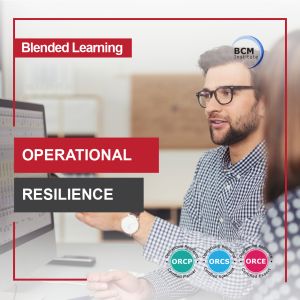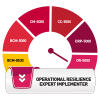Operational Resilience Framework: Difference between revisions
No edit summary |
No edit summary |
||
| Line 1: | Line 1: | ||
{| style="margin-left: 0px; text-align: left; font-style: none; width:100%; font-weight: none; background: #F0F0F0; border:1px" | {| style="margin-left: 0px; text-align: left; font-style: none; width:100%; font-weight: none; background: #F0F0F0; border:1px" | ||
|- | |- | ||
| '''1.''' Operational Resilience Framework is | | '''1.''' Operational Resilience Framework is a comprehensive structure that outlines how an organisation identifies, manages, and adapts to disruptions that threaten its critical business functions. | ||
| Line 9: | Line 9: | ||
'''''Notes (2)''''': should focus on the approved pillars of operational resilience.''' | '''''Notes (2)''''': should focus on the approved pillars of operational resilience.''' | ||
'''''Notes (3)''''': It encompasses the processes, governance, roles, tools, and metrics used to build resilience across the enterprise. | |||
'''''Notes (4)''''': Its purpose is to provide a structured, strategic, and holistic approach to achieving operational resilience objectives. | |||
'''''Notes (5)''''': Its scope is broad and system-wide, often incorporating multiple disciplines such as risk management, business continuity, IT disaster recovery, third-party risk, cyber resilience, and crisis management. | |||
'''''Notes (6)''''': Its focus is on implementing and integrating operational resilience capabilities. | |||
{{Template:BL-OR-5 banner}} | {{Template:BL-OR-5 banner}} | ||
Revision as of 22:31, 5 April 2025
| 1. Operational Resilience Framework is a comprehensive structure that outlines how an organisation identifies, manages, and adapts to disruptions that threaten its critical business functions.
Notes (1): should be implemented so that the entire organisation can adopt and promote the desired OR behaviours. These consist of specific OR actions and processes. Notes (2): should focus on the approved pillars of operational resilience. Notes (3): It encompasses the processes, governance, roles, tools, and metrics used to build resilience across the enterprise. Notes (4): Its purpose is to provide a structured, strategic, and holistic approach to achieving operational resilience objectives. Notes (5): Its scope is broad and system-wide, often incorporating multiple disciplines such as risk management, business continuity, IT disaster recovery, third-party risk, cyber resilience, and crisis management. Notes (6): Its focus is on implementing and integrating operational resilience capabilities.

 
| ||||||||||||||||||||||||||||||||||||

